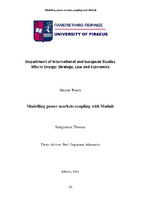Modelling power markets coupling with Matlab

Master Thesis
Συγγραφέας
Σαρηγιάννης, Θωμάς
Sarigiannis, Thomas
Ημερομηνία
2021Επιβλέπων
Dagoumas, AthanasiosΔαγούμας, Αθανάσιος
Προβολή/
Λέξεις κλειδιά
Market coupling ; Energy marketsΠερίληψη
The dawn of 21st century has found the energy sector in a transition phase. The liberalization of the industry has forced the, once powerful State-owned, companies to abandon their single-integrated model and adopt a new state of competition, in every part of
the sector. Thus, energy companies would begin to compete with each other in generation, retailing, transmission and distribution. Countries would find themselves adopting different models, based on their desirable benefits, with the most popular one consisting of independent transmission and distribution operators (TSO and DSO) which coordinate market operation. With the European Green Deal in effect and the de-carbonization shift in progress, Europe aims to interconnect all electricity market, integrating into a single market. The process of market coupling will achieve price convergence between members, as well as
maximize exploitation of decentralized renewable energy sources.


